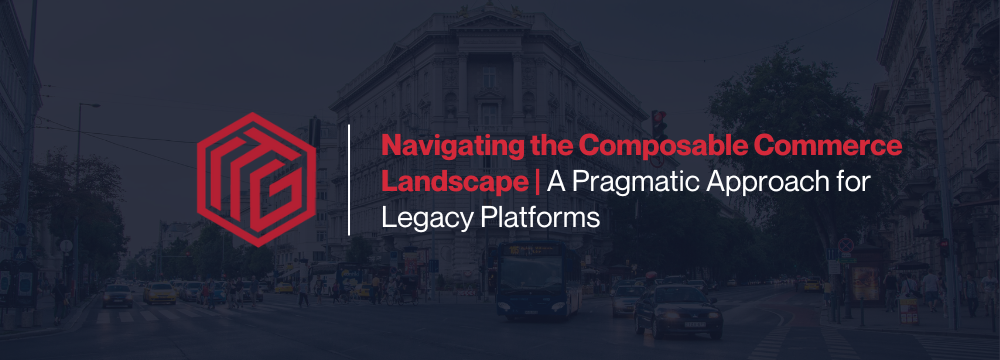The never ending discussion around “composable commerce” continues as businesses look ahead to optimize their spend to either evolve their digital commerce capability or completely re-platform possibly going “MACH” or “fully composable”. While some businesses can justify such revolutionary paths, it involves a significant investment of time, budget, and introduces risks.
If you’ve read our previous post, Composable Commerce Explained & What Adobe’s API Mesh Means For Adobe Commerce or the recent Cocktails and Commerce newsletter, you’re likely working to formulate a “composability” narrative for your digital roadmap.
Composable is Not Really New. So What’s the Big Deal?
The simple explanation of composable commerce sounds a lot like what vendors, pundits, and analysts have been talking about for a long time – making it easier to leverage best-of-breed solutions that can deliver significant value compared to what you get from the commerce platform provider. Over the years, pre-built connectors and accelerators have burgeoned, aiming to reduce costs, mitigate risks, and expedite deployments through a modular approach.
However, the game-changer lies in the integration methods and how systems grapple with the growing complexity of data, particularly for personalization scenarios. The shift to advanced, standardized APIs like GraphQL marks a departure from the point-to-point integrations of the past, offering a more sustainable and adaptable approach to evolving user journeys.
Navigating the Paradigm Shift
In the contemporary composable world, relying on a cache of pre-built connectors stitched together by a single system integrator is no longer a realistic strategy. Today’s advanced APIs, particularly those based on GraphQL, simplify the process of connecting disparate systems, services, and applications. It’s about more than just integration – it’s about orchestrating workflows and automating business processes with a focus on creating compelling user journeys.
A more flexible approach to integration is focused on coordinating and automating workflows or business processes that involve multiple tasks and systems, rather than just connecting and integrating different systems to enable them to work together. Often, you will hear this concept referred to as orchestration or even an orchestration layer or platform. These platforms are designed to automate and optimize end-to-end business processes by orchestrating the execution of tasks leveraging these powerful APIs that are available across a host of different software solutions.
Flexible Approach for Legacy Commerce Platforms
The key to a flexible integration approach lies in orchestration – a process of coordinating and automating end-to-end business processes across multiple systems. Unlike traditional Integration Platforms, orchestration solutions are designed for business users and process owners, offering low-code or no-code capabilities that empower non-technical users, prioritizing the automation and optimization of business processes.
Leveraging an orchestration approach can offer a compelling alternative to a comprehensive re-platforming effort. Whether you’re integrating best-of-breed solutions into your existing ecosystem or addressing complex process challenges, orchestration can provide a pragmatic and flexible solution. By optimizing existing APIs and empowering non-technical users, orchestration aligns with the goals of becoming more or fully composable without the need for a complete overhaul.
Rationalizing Roadmap Investments
There is no one-size-fits-all answer here, as it depends on the size and maturity of your digital footprint. A key consideration is understanding your platform vendor’s roadmap to support composability. Salesforce continues to leverage Mulesoft and marketplace connectors to address complexity and composability. Adobe and SAP have also invested in marketplace options for connectors, but a nagging question remains about how up-to-date these are and which ones are actually aligned with where these vendors are going.
Adobe Commerce is a good example of a legacy platform that is investing in the orchestration layer approach through something they call API Mesh, together with App Builder. This supports not only integrations of third-party solutions but also provides an extensibility framework for building custom applications. All of this is designed to incorporate GraphQL not only from Adobe but also from other third-party APIs. These capabilities are relatively new and may be challenging to fully leverage without the right system integrator partner.
As businesses contemplate the composable commerce landscape, extending the life of legacy commerce platforms remains a viable option. Whether through marketplace connectors, integration platforms, or an orchestration approach, the key to success lies in aligning with the right system integrator to navigate the complexities and realize the full potential of a composable future.

Former GM, Enterprise Commerce at Adobe and NA Sales leader for SAP Commerce, hybris, and Endeca, now Founder and Principal at StrategyēM, a boutique strategic advisory firm focused on commerce tech and services industry – and Co-Chief Mixologist at Cocktails & Commerce.

